
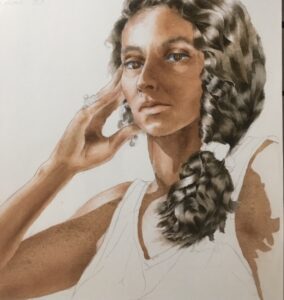
(with European Editor Daniel Nanavati, conducted over Skype)
You obviously always wanted to be an artist?
DN: Yes. When I was in high school, I graduated in the 70s, back then I was told that there wasn’t very much money and we had one boy and three girls. So if someone was going to go to college it was going to be my brother because he would have to support a family. The girls would find someone to marry and be taken care of. That was the thinking. But I still wanted to go, so my mother went to the art school and talked to the art teacher and asked if I had any talent and she said no but she works very hard. So I didn’t get to go to school. I still wanted to go, so I got the work-study program. I just
started the core classes for college, but modelling paid the most, so I nude-modelled for the art classes. And then I started modelling for Dewitt. He was like a pretty well-known artist in New England, he’s in the Smithsonian, Library of Congress – he had a different style of watercolour and I would say show me how to do that, do that again. I would trade him modelling to teach me to paint. So I never had a formal education. The only thing I know how to do is watercolour in the way Dewitt taught me. I just know what he knows.
So he was your mentor?
DN: Yes. Even if I didn’t live there, sometimes I would be working on something I would mail him and have him correct it or or do something on a separate page if I had a problem. I have the book of my work that was put out by Gates Museum. When he first started watercolour he had no heavy shadows, which he didn’t know how to do then. I did line and painting the flesh tones in ’93. Then I first started doing the shiny hair. The dark shadows, the heavy scary part that goes on last after everything else. Watercolours are very many layers. I mix the paint with a very thick wash and then I lay it down, then I wash out the brush and I shake it over the floor, then I pick up the water around the edges, keep picking it up and shaking it and squeezing it out of the brush over and over until only the pigment that settled in the paper is left. Then I blow dry it. Then I put another layer. I do it over and over and over and over so it takes hours, many, many layers, but that’s how I get that quality.
So the shiny hair which is a feature of your work. Is that your own experimentation or did he teach you how to do that?
DN: Oh, that’s me with the hair. His hair, if you see his work, is not like this. When he saw this hair, which was probably when we started doing the stripper stuff, maybe in ’98, he said ‘you know what that looks like? That looks like Tamara De Lempicka. I wondered what would happen if I made the skin shiny because nobody has ever made shiny in watercolour that I knew of. I did a few like that but I kept doing the hair like that.
Were you exhibiting?
DN: I had a gallery in the back of an old beauty shop. I lived in at the back.
In Florida?
DN: No this was in Maine. I had this for summer before I moved to Key West. It was like a good summer. Dewitt put a lot of clutter in his paintings and I think that’s why I do that. I w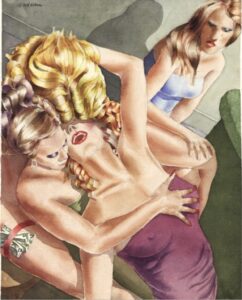 ould send the painting and he would send them back and I learned to do the shadows and used his colours.
ould send the painting and he would send them back and I learned to do the shadows and used his colours.
So more than just your teacher, he is your inspiration?
DN: Yeah. With the stripper paintings. I was dancing, before I had the gallery, and I said to the girls, somebody has to tell people what this is about. This is a whole world and nobody knows our side; all they know is the men’s side. When they come in here and they think we’re sluts, they give us the money, it’s a thing that everyone’s ashamed of, and you don’t admit that you did the job. You don’t admit anything about it. You don’t admit you go into those clubs. And all the guys are really trying to get over on their wife or whatever. They’re the ones really being scummy but there’s a whole life, there’s a whole other side no one has ever talked about, So I was like, I’m gonna paint about this, somebody has to tell the world, so that is when I started doing stripper stuff.
Has your painting changed?
DN: Some since the ones I did with Dewitt. My flesh tones are not similar to his any more. My work is stronger since the ones I did with Dewitt. I still have some shiny hair but I have put shadow over it. So it has changed and evolved since then. I had the photographs but I wasn’t thinking about lighting at the time. It was kinda dark in the dressing rooms so I would just take pictures of everybody while we are working. I had to make sure they didn’t look repetitious. I sometimes had to relight my self portraits. I would pose in the mirror with another mirror and see where the shadows fell. I did have trouble with the hands and he would help me. So some of the things he drew on, some he did washes on. He made me do them over and over. I’m a mimic, I can run nothing out of my head. I pose myself in the mirror for whatever I need.
How was the exhibition?
DN: People at the show were just amazed and they said ‘you know. I never thought that there was another side’. I quit painting in 2003 because I was so discouraged with everybody’s rejection of these as pornography. It’s erotic art, it’s offensive. In Key West people run around naked but they wouldn’t show me in the galleries.
What did you do?
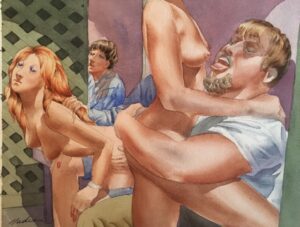
DN: I did some pottery. So, I had these customers over at the college. I worked for them and, you know, by making stuff for … say I would make 60 of something that needed to be made for a convention of all the heads of the colleges. Whatever the little job was. I was there for like 15 years. These paintings take me so long. A smaller one takes 214 hours. The drawing takes a long time because once the line is down you can’t fix it later. So I made pots until Jeff saw the stripper stuff and saw the notes I made on the back, telling the stories. He said this is a documentary of your life, Darren Jones, your New York Editor, said, ‘I feel like I just discovered a hidden treasure’ and they got Studios Key West to come over and they offered me a show for the stripper stuff.
Usually people have low self-esteem that do it to start with. You can tell a girl that is brand-new because she thinks she’s a star. She’s so pretty and the guys like her. She has a great time for about a year/year and a half. By then she hates them all too. A lot of them were cheerleaders, or majorettes, or they worked at Hooters. It’s the money that sucks you in to start with. All the strippers end up bisexual, into drugs. There were all kinds of drug guys with pockets full of hundred dollar bills. In my next show I am going to do a retrospective of how it used to be. Now they jump on the guys’ laps and go in the back and grind all over them. It wasn’t like that. Back in the day guys came in for someone to talk to because they talked to women better than with other men. They would come in for conversation more than anything else. I didn’t get into heavy, heavy drinking until I was busted by the cops who set us up because they knew we knew who the drug dealers were, and I lost my job. I needed to give up lap-dancing and that gives you the heebie-jeebies because for the first time they could touch me. I drank so I could put up with it.
When did you begin to paint these scenes?
DN: I had saved $15,000 in 1980 and bought a little land which got zoned so I lost it. I went to Vegas, and worked for a year and half and I hated it there. Lots of girls there committed suicide. I took a year off and painted landscape, and I did a lot of food painting, so pastries and stuff and I would sell them for like $75 in the coffee shop and to a little gallery. I would see Dewitt when I came home. I didn’t think about doing the painting, until I quit.
Do the paintings have an element of fulfilment?
DN: This is something that had to be done before I die. This is my mark that I’m leaving as far as I’m concerned, and hopefully it gets awareness for the what happens on the other side.
When you exhibit do you have the stories on the back?
DN: Yes. The Rule is about a girl who is very depressed. Something made her come back. We were all given fines. There were signs for things like do not hit the customers with beer bottles, call the bouncer! Do not bring drugs onto the property.
Have you kept friendships with the girls?
DN: Yes. We still see each other. Not all but some. I saw girls with tattoos on their back saying ‘Property of’ followed by the name of their boyfriend. They would give whoever he was all their money. A lot of the girls developed drug habits. Some were ruthless about getting money to feed their habit. We got money for sitting topless on boats just to adorn the boat.
I also see you paint people’s houses.
DN: Yes I’ve done a lot of those. But architecture is commissioned. Compared to these paintings, not a lot of people can paint figures in watercolours like this. The first people who helped me exhibit and sell didn’t
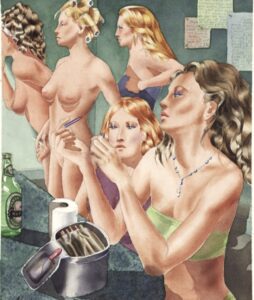
want me to tell anyone I did stripper stuff. Even my sister thinks writing about me puts the family in a bad light, while my mother helped me by posing in the mirror. My own sister! It’s amazing how conservative all these galleries are.
But artists are the conscience of society.
DN: People just paint what the galleries want. I can paint anything they want but it’s not what I want to paint. People love the paintings but they don’t want to put them in their house. But if you don’t like nudes, my son who went with me to Paris, said in that case you really need to stay out of the Louvre.
It’s been lovely talking to you. Thank you.
Volume 34 no 5 May / June 2020
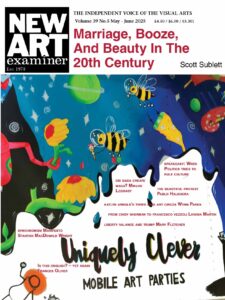

Donna is a true inspiration and I am fortunate enough to own a piece of her are. It truly is an honor.